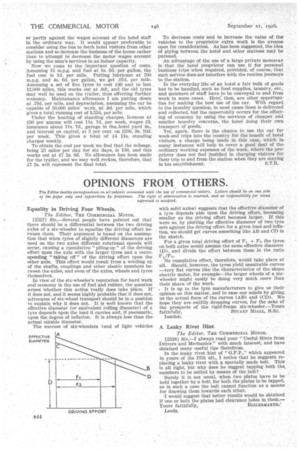OPINIONS FROM OTHERS.
Page 62

If you've noticed an error in this article please click here to report it so we can fix it.
The Editor invites correspondence on all subjects connected with the use of commercial motors. Letters should be on one-side of the paper only and typewritten by preference. The right of abbreviation is reserved, and no responsibility for views expressed is accepted.
Equality in Driving Four Wheels, The Editor, THE COMMERCIAL MOTOR.
12527] Sir,—Several people have pointed out that there should be a differential between the two driving axles of a six-wheeler to equalize the driving effort between them. Their argument is based on the assumption that when tyres of slightly different diameters are used on the two axles different rotational speeds will occur, causing a cumulative " piling-up " of the driving effort upon the axle with the larger tyres and a corresponding "taking off" of the driving effort upon the other axle. This effect would result from a winding up of the shafts, couplings and other elastic members between the axles, and even of the axles, wheels and tyres themselves.
In view of the six-wheeler's reputation for hard work and economy in the use of fuel and rubber, the question arises whether this action really does take place. If it does not, and it seems highly probable that It does not, advocates of six-wheel transport should be in a position to explain why it does not. It is well known that the effective diameter (or equivalent rolling diameter) of a tyre depends upon the load it carries and, if pneumatic, upon the degree of inflation. It is always less than the actual outside diameter.
The success of six-wheelers (and of light vehicles with solid axles) suggests that the effective diameter of a tyre depends ago upon the driving effort, becoming smaller as the driving effort becomes larger. If this were so, by plotting the effective diameter of two tyre sets against the driving effort for a given load and inflation, we should get curves something like AB and CD in the sketch.
For a given total driving effort of F1 + Fl the tyres on both axles would assume the same effective diameter (D), and divide the effort between them in the ratio F1/F5.
No cumulative effect, therefore, would take place at all. Should, however, the tyres yield unsuitable curves —very fiat curves like the characteristics of the shunt electric motor, for example—the larger wheels of a sixwheeler might easily be doing very much more than their share of the work.
. It is up to the tyre manufacturers to give us their opinion on this matter, and to ease our minds by giving us the actual form of the curves (AB) and (CD). We hope they are swiftly dropping curves, for the sake of the prospects of the rigid:frame six-wheeler.—Yours faithfully, STUART MIALL, B.Sc. London.
A Leaky Rivet Hint.
The Editor, THE COMMERCIAL MOTOR.
[25281 Sir,—I always read your "Useful Hints from Drivers and Mechanics" with much interest, and have obtained many useful tips therefrom.
In the leaky rivet hint of " G.F.P.," which appeared in yours of the 17th ult., I notice that he suggests replacing a leaky rivet with a specially made bolt. This is all right, but why does he suggest tapping both the members to be united by means of the bolt?
Surely it is not usual, when two plates have to be held together by a bolt, for both the plates to be tapped, as in such a case the bolt cannot function as a means for drawing them towards each other. I would suggest that better results would be obtained If one or both the plates had clearance holes in them.— Yours faithfully, Bon,ERmAKErt." Leeds.




































































































